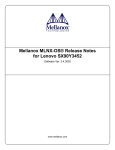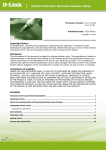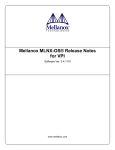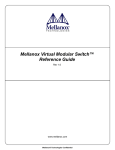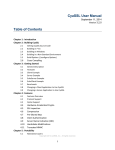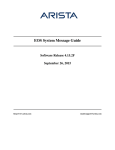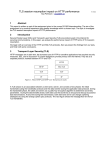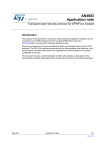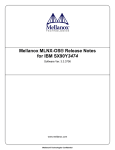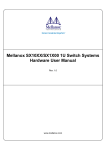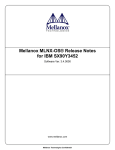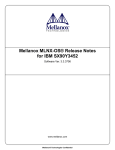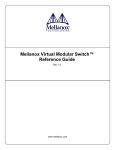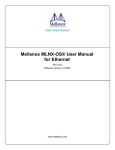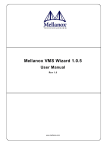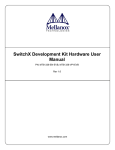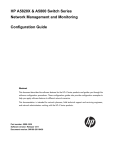Download Mellanox MLNX-OS® Release Notes for Ethernet
Transcript
Mellanox MLNX-OS® Release Notes
for Ethernet
Software Ver. 3.4.3002
www.mellanox.com
2
Mellanox Technologies Confidential
Table of Contents
Chapter 1 Introduction . . . . . . . . . . . . . . . . . . . . . . . . . . . . . . . . . . . . . . . . . . . . . . . . . . . . 4
Chapter 2 Supported Platforms, Firmware, Cables and Licenses . . . . . . . . . . . . . . . . . 4
2.1
2.2
2.3
2.4
2.5
2.6
Supported Switch Systems. . . . . . . . . . . . . . . . . . . . . . . . . . . . . . . . . . . . . . . . . . .
Supported CPU Architecture . . . . . . . . . . . . . . . . . . . . . . . . . . . . . . . . . . . . . . . . .
Supported Firmware . . . . . . . . . . . . . . . . . . . . . . . . . . . . . . . . . . . . . . . . . . . . . . .
Supported Software Licenses. . . . . . . . . . . . . . . . . . . . . . . . . . . . . . . . . . . . . . . . .
Upgrade From Previous Releases . . . . . . . . . . . . . . . . . . . . . . . . . . . . . . . . . . . . .
Supported Cables . . . . . . . . . . . . . . . . . . . . . . . . . . . . . . . . . . . . . . . . . . . . . . . . . .
4
4
4
5
5
6
Chapter 3 Changes and New Features . . . . . . . . . . . . . . . . . . . . . . . . . . . . . . . . . . . . . . . 7
Chapter 4 Known Issues . . . . . . . . . . . . . . . . . . . . . . . . . . . . . . . . . . . . . . . . . . . . . . . . . . 12
4.1
4.2
4.3
General Known Issues . . . . . . . . . . . . . . . . . . . . . . . . . . . . . . . . . . . . . . . . . . . . . 12
Ethernet Known Issues . . . . . . . . . . . . . . . . . . . . . . . . . . . . . . . . . . . . . . . . . . . . 15
IP Routing Known Issues . . . . . . . . . . . . . . . . . . . . . . . . . . . . . . . . . . . . . . . . . . 21
Chapter 5 Bug Fixes. . . . . . . . . . . . . . . . . . . . . . . . . . . . . . . . . . . . . . . . . . . . . . . . . . . . . . 27
5.1
5.2
General Bug Fixes . . . . . . . . . . . . . . . . . . . . . . . . . . . . . . . . . . . . . . . . . . . . . . . . 27
Security Bug Fixes. . . . . . . . . . . . . . . . . . . . . . . . . . . . . . . . . . . . . . . . . . . . . . . . 28
Chapter 6 Submitting a Service Request . . . . . . . . . . . . . . . . . . . . . . . . . . . . . . . . . . . . . 31
Mellanox Technologies Confidential
3
1
Introduction
This document is the Mellanox MLNX-OS® Release Notes for Ethernet.
MLNX-OS is a comprehensive management software solution that provides optimal performance for cluster computing, enterprise data centers, and cloud computing over Mellanox
SwitchX® family. The fabric management capabilities ensure the highest fabric performance
while the chassis management ensures the longest switch up time.
The MLNX-OS documentation package includes the following documents:
•
User Manual – provides general information about the scope, organization and command line interface of MLNX-OS as well as basic configuration examples
•
Release Notes – provides information on the supported platforms, changes and new features, and reports on software known issues as well as bug fixes
2
Supported Platforms, Firmware, Cables and Licenses
2.1
Supported Switch Systems
Table 1 - Supported Switch Systems
Model Number
2.2
2.3
Description
MSX1036
36-Port QSFP 40GbE 1U Ethernet switch system
MSX1024
12-Port QSFP 40GbE 48-Port SFP+ 10GbE 1U Ethernet switch system
MSX1024(52)
4-Port QSFP 40GbE 48-Port SFP+ 10GbE 1U Ethernet switch system
MSX1016
64-Port SFP+ 10GbE 1U Ethernet switch system
MSX1012
12-Port QSFP (40GbE) 1U Ethernet switch system
MSX1400
48-Port SFP+ 10GbE, 12-Port QSFP 40GbE 1U x86 Ethernet switch system
MSX1410
48-Port SFP+ 10GbE, 12-Port QSFP 40GbE 1U dual core x86 Ethernet switch
system (engineering sample)
MSX1710
36-Port QSFP 40GbE 1U Ethernet dual core x86 switch system
MSX1710_O
36-Port QSFP 40GbE 1U Ethernet dual core x86 switch system with ONIE
Supported CPU Architecture
•
PPC 460
•
x86
Supported Firmware
•
SwitchX® firmware version 9.3.5080
•
SwitchX®-2 firmware version 9.3.5080
•
ConnectX®-2 firmware version 2.9.1000 and higher
•
ConnectX®-3 firmware version with SwitchX® based systems 2.33.5000 and higher
Mellanox Technologies Confidential
4
2.4
Supported Software Licenses
For the software licenses supported with MLNX-OS® software please refer to the “Licenses”
section of the “Getting Started” chapter of the Mellanox MLNX-OS User Manual.
2.5
Upgrade From Previous Releases
Older versions of MLNX-OS may require upgrading to one or more intermediate versions prior
to upgrading to the latest. Missing an intermediate step may lead to errors. Please refer to Table 2
and Table 3 to identify the correct upgrade order.
Table 2 - Supported Software Upgrades for PPC Systems
Target Version
Verified Versions From Which to Upgrade
3.4.3002
3.4.2306; 3.4.2008; 3.4.1120
3.4.2306
3.4.2008; 3.4.1120
3.4.2008
3.4.1954; 3.4.1950; 3.4.1804 ; 3.4.1120; 3.4.0012
3.4.1120
3.4.1110; 3.4.1100; 3.4.0012
3.4.1110
3.4.1100; 3.4.0012
3.4.0012
3.3.5006; 3.3.4402
3.3.5200
3.3.5006; 3.3.4402
3.3.5006
3.3.4402; 3.3.4304
3.3.4402
3.3.4304; 3.3.4100
3.3.4304
3.3.4100; 3.3.3500
3.3.4100
3.3.3500; 3.3.3000
Table 3 - Supported Software Upgrades for x86 Systems
Target Version
Verified Versions From Which to Upgrade
3.4.3002
3.4.2008; 3.4.1120
3.4.2306
3.4.2306; 3.4.2008; 3.4.1120
3.4.2008
3.4.1120; 3.4.0012
3.4.1120
3.4.1110; 3.4.1100; 3.4.0012; 3.3.5006
3.4.1110
3.4.1100; 3.4.0012; 3.3.5006
3.4.0012
3.3.5006
3.3.5200
3.3.5006; 3.3.4402
3.3.5006
3.3.4406; 3.3.4304
Mellanox Technologies Confidential
5
For upgrade instructions refer to the section “Upgrading MLNX-OS Software” in Mellanox
MLNX-OS User Manual.
Downgrading from MLNX-OS version 3.4.0012 or later on x86 switch systems is not
supported.
2.6
Supported Cables
For a list of the Mellanox supported cables please visit the LinkX™ Cables and Transceivers
page of the Mellanox Website at http://www.mellanox.com/page/cables?mtag=cable_overview.
When using Mellanox AOC cables longer than 50m use one VL to achieve full wire
speed.
Mellanox Technologies Confidential
6
3
Changes and New Features
Table 4 - Ethernet Changes and New Features
Category
Description
Release 3.4.3002
Security
Added support for switch secure mode
User Accounts
Improved logic of AAA authorization map order
See the command “aaa authorization map order” in the User Manual
System Management
Added support for auto-BIOS upgrade for SX1400 and SX1710 switch systems
Chassis Management
Added new System Health Monitor notification alert
See the section “System Health Monitor Alerts Scenarios” in the User Manual
CLI
Improved module status display
See command “show module” in the User Manual
Software
Management
Added support for MLNX-OS over ONIE
See section “Image Maintenance via Mellanox ONIE” in the User Manual
Software
Management
Removed requirement for 56GbE license
See section “Licenses” in the User Manual
XML API
Improved XML interface
Refer to MLNX-OS® XML API Reference Guide for more information
Ethernet Switching
Added support for QinQ
See section “QinQ” in the User Manual
802.1x Protocol
Added support for single-host 802.1x authentication protocol
See section “802.1x Protocol” in the User Manual
PIM
Added support for next-hop load balancing
See section “Next Hop Load-Sharing” in the User Manual
Release 3.4.2008
CLI
Modified user interface for the command “show asic version”
CLI
Improved module hierarchy in the output of the commands “show power” and
“show temperature”
CLI
Removed CPU component from the output of the command “show inventory”
SNMP
Applied new index scheme for SNMP EntityTable
Ethernet Switching
Added support for multiport 802.1x authentication protocol
See section “802.1x Protocol” in the User Manual
IP Routing
Added support for VRF with static IPv4 and ECMP
See section “Virtual Routing and Forwarding” in the User Manual
PIM
Added GA support for PIM Load-Sharing
See section “PIM Load-Sharing” in the User Manual
Mellanox Technologies Confidential
7
Table 4 - Ethernet Changes and New Features
Category
Description
IPv6
Added support for IPv6 over loopback port
MLAG
Support for MLAG fast recovery
Release 3.4.1120
General
Removed “sx_” prefix from version numbers in the code
Release 3.4.1110
General
Bug fixes
Release 3.4.1100
LACP
Added support for specific port in the command “show lacp neighbor”
Ethernet Switching
Added GA support for RPVST
See section “RPVST” in the User Manual
Ethernet Switching
Added support for LACP individual mode
See the command “suspend-individual” in the User Manual
Ethernet Switching
OpenFlow bitwise IP match
Ethernet Switching
Added support for BPDU guard
See the command “spanning-tree port type” in the User Manual
IP Routing
Added GA support for IPv6
See section “IPv6 Routing” in the User Manual
IP Routing
Added support for VRRP counters
IP Routing
Added prefix filter in the command “show ip route <ip-address>”
MAGP
Added “MAGP disabled” indication in the command “show magp” when
applicable
SNMP
Added support for SNMP SET upgrade
See section “Upgrading MLNX-OS Software with SNMP” in the User Manual
WebUI
Added popup Welcome screen when connecting via WebUI
See section “Starting the Web User Interface” in the User Manual
Security
Added default passwords to the XML default users
See section “User Accounts” in the User Manual
Release 3.4.0012
Security
Changed the HTTPS default ciphers to TLS.
IP Routing
GA support for PIM Bi-Dir.
See section 6.3 “Multicast (IGMP and PIM)” in the User Manual.
IP Routing
Added support for ICMP redirect.
See command “ip icmp redirect” in the User Manual.
Ethernet Switching
Added support for disabling MAC-address learning.
Mellanox Technologies Confidential
8
Table 4 - Ethernet Changes and New Features
Category
Description
General
Added support for Mellanox OFED 2.3 integration.
Interconnect
Added support for LR4 modules on Ethernet switch systems.
IP Routing
GA support for BGP.
See section 6.3 “BGP” in the User Manual.
MLAG
Added support for MLAG LACP.
Security
Added support for security strict mode.
SNMP
Added support for setting hostname through SNMP.
See section 4.17.1.7 “SNMP SET Operations” in the User Manual.
SNMP
Added support for power cycling through SNMP.
See section 4.17.1.7 “SNMP SET Operations” in the User Manual.
SNMP
Added support for changing configuration through SNMP.
See section 4.17.1.7 “SNMP SET Operations” in the User Manual.
Systems
GA support for SX1710 switch systems.
Virtual Machine
GA support for Virtual Machine for x86-based switch systems.
See section 4.19 “Virtual Machine” in the User Manual.
WebUI
Added support for Internet Explorer 11 web browser.
Release 3.3.5200
IP Routing
GA support for Router Port.
See Chapter 6 “IP Routing” in the User Manual.
IP Routing
Proof of concept support for BGP.
See section 6.3 “BGP” in the User Manual.
IP Routing
GA support for route maps.
See section 6.4 “Route Map” in the User Manual.
IP Routing
GA support for PIM Bi-Dir.
See section 6.6 “Multicast (IGMP and PIM)” in the User Manual.
IGMP Querier
GA support for IGMP Querier.
See section 5.8.3 “IGMP Snooping Querier” in the User Manual.
SNMP
Added SNMP traps for VLAN Interface, MLAG port channel and Port channel
link up/down events.
SNMP
Added MSTP MIBs/traps support.
Release 3.3.5006
Ethernet Switching
GA support for MLAG.
ACLs
Added MAC-based VLAN ACL.
IP Routing
GA support for MAGP.
Mellanox Technologies Confidential
9
Table 4 - Ethernet Changes and New Features
Category
Description
IP Routing
GA support for VRRP.
IP Routing
GA support for IGMP.
IP Routing
Alpha support for PIM.
OSPF
Loopback interface on OSPF.
OSPF
Added new OSPF MIB/Traps.
Release 3.3.4664
IP Routing
Alpha support for MAGP.
IP Routing
Alpha support for VRRP.
SNMP
Added cable info entries to entPhysicalTable.
SNMP
Added support for SNMP to trigger SNMP test trap via SNMP set command.
See section “MLNX-EFM MIB”.
SNMP
Added system identifier (MAC address) to test trap.
Release 3.3.4402
General
Added new certificate hashing algorithm (sha256).
See section “Cryptographic (X.509, IPSec)” in the User Manual.
General
The command “show configuration full” is no longer supported.
CLI
Added support for command output filtering.
See section “Command Output Filtering” in the User Manual.
DCBX
Added support for LLDP-DCBX CEE TLVs.
Release 3.3.4304
General
Added End-User License Agreement.
See section “Getting Started” in the User Manual.
General
Improved configuration file format.
Power Management
Added support for link width reduction.
Systems
New CPU temperature for MSX10xx systems.
Systems
Beta support for x86 CPU family-based systems (MSX1400 and MSX1700).
Puppet Agent
GA support for Puppet.
See section “Puppet Agent” in the User Manual.
Ethernet Switching
GA support for debug per protocol.
OpenFlow
GA support for OpenFlow.
See section “OpenFlow” in the User Manual.
DCBX
GA support for DCBX.
See section “DCBX” in the User Manual.
Mellanox Technologies Confidential
10
Table 4 - Ethernet Changes and New Features
Category
Description
MSTP
GA support for MSTP protocol.
See section “MSTP” in the User Manual.
DHCP Relay
GA support for DHCP relay.
See section “DHCP Relay” in the User Manual.
IGMP Snooping
GA support for IGMP Querier relay.
See section “IGMP Snooping Querier” in the User Manual.
Release 3.3.4100
General
Improved debug file upload mechanism.
Refer to “file debug-dump” command in the CLI reference guide.
General
Added support for displaying system hardware revision.
Refer to “show inventory” command in the CLI reference guide.
SNMP
Added a MELLANOX-ENTITY-MIB as an extension to the standard
ENTITY-MIB to represent system GUID.
Refer to SNMP chapter in the User Manual. The new MIB can be found in
Mellanox support website.
Logging
Added support for event notification to monitor.
Refer to “Event Notification” section in the User Manual.
Chassis Management
Improved temperature control algorithm.
User Interfaces
Improved login timeout mechanism.
OSPF
NSSA area type support.
Refer to “area nssa” command in the OSPF chapter of the CLI guide.
Release 3.3.4000
Systems
SX1012 supported at GA level.
General
Bug fixes.
Release 3.3.3500
IP Routing
OSPF support (GA level).
Management
Interfaces
In-band management.
Ethernet Switching
Port mirroring.
Ethernet Switching
sFlow.
IP Routing
OSPF support (beta level).
Mellanox Technologies Confidential
11
4
Known Issues
The following sections describe MLNX-OS® known issues in this software release and possible
workarounds.
For hardware issues, please refer to the switch support product page.
4.1
General Known Issues
Table 5 - General Known Issues (Sheet 1 of 4)
Index
Category
Description
Workaround
1.
Management
Interfaces
The command reset factory keep-basic
removes management IP configuration.
N/A
2.
Management
Interfaces
The CLI command ip default-gateway
<interface> sets the gateway address to
0.0.0.0 and prevents the user from adding other
gateways.
Delete the entry by using
the command no ip
default-gateway.
3.
Management
Interfaces
The “no” negation prefix is not supported prefix in the following CLI commands:
Use the “no” keyword as
an infix (e.g. interface
port-channel <num> no
switchport).
•
•
interface ethernet <s/p> ipv4 port access-group
nodhcprelay
interface port-channel <num> switchport mode
4.
Management
Interfaces
Switch systems may have an expired HTTPS
certification.
Generate a new certificate
by changing the hostname.
5.
Management
Interfaces
Consecutive hostname modification is not supported.
Wait 25 seconds before
reattempting to modify the
hostname.
6.
Puppet Agent
Only the resource ID “default” is supported for
Puppet router.
N/A
7.
Puppet Agent
Duplex parameter is not supported for Ethernet
or LAG interfaces.
N/A
8.
In-Band
Management
In-band management mode does not support
IPv6.
N/A
9.
In-Band
Management
In-band management ARPs are not taken into
account in the command show ip arp count.
N/A
10.
In-Band
Management
In-band management is not operational without
an L3 license.
Contact Mellanox to get
L3 license for free.
11.
NTP
The command show ntp always lists the last
configured NTP server even if it has been
deleted. This output can be safely ignored.
N/A
Mellanox Technologies Confidential
12
Table 5 - General Known Issues (Sheet 2 of 4)
Index
Category
Description
Workaround
12.
Software
Management
Only one image is allowed to be copied into the
system (using the image fetch command). The
user must remove old image files prior to fetching a new one.
N/A
13.
User Accounts
If AAA authorization order policy is configured to remote-only, then when upgrading to
3.4.3002 or later from an older MLNX-OS version, this policy is changed to remote-first.
N/A
14.
Configuration
Management
Loading the wrong system configuration file
may hang the system.
For example: an attempt to use an SX1016 configuration file on an SX6036/SX6536/SX1035
system may cause the system to hang.
N/A
15.
Configuration
Management
After loading a new configuration file, please
reboot the system. Otherwise, configuration
may not be properly applied and errors may
appear in the log.
N/A
16.
Configuration
Management
When using a large set of configuration files,
configuration apply can take more time than
usual due to parallel activity of statistics data
collecting.
N/A
17.
Configuration
Management
Applying a configuration file of one system
profile to another is not supported.
N/A
18.
Configuration
Management
If the last box leaving an HA (MLAG/) cluster
is not the box on which the cluster was created,
bogus configuration will result which does not
allow recreating the same cluster name.
N/A
19.
Configuration
Management
Sending packets to a non-default port in TFTP
transport layer is not supported.
N/A
20.
Logging
“DROPPED MSG” errors may appear during
reload (shutdown phase). These errors can be
safely ignored.
N/A
21.
Logging
The warning “pgm_set_timeout” may appear in
the log. This warning can be safely ignored.
N/A
22.
Logging
During system de-init, the error “[mdreq.ERR]:
init(), mdr_main.c:634, build 1: Error code
14014” may appear in the log. This error can be
safely ignored.
N/A
Mellanox Technologies Confidential
13
Table 5 - General Known Issues (Sheet 3 of 4)
Index
Category
Description
Workaround
23.
Logging
The warning “[mgmtd.WARNING]: Upgrade
could not find node to delete: /iss/config/stp/
switch/ethernet-default/spanning-tree/mode”
may appear in the log. This warning can be
safely ignored.
N/A
24.
Logging
When using a regular expression containing |
(OR) with the command show log [not]
matching <reg-exp>], the expression should
be surrounded by quotes (“<expression>”),
otherwise it is parsed as filter (PIPE) command.
N/A
25.
Logging
Port up/down events on a port quickly toggling
states may be displayed in wrong order in the
monitoring terminal.
For actual port stats, use
the command show
interface.
26.
Logging
The following error may appear in the log:
“sn_mdc_msg_handler(), ../../tms/
sn_mgmt.c:910, build 1: Error code 14002
(assertion failed) returned”. This error may be
safely ignored.
N/A
27.
User Management
Some RADIUS and TACACS+ configurations
keep the user locked out of the machine due to
timeout limitation.
Press the reset button for
15 seconds, and then log
in using your local authentication. Additionally, fix
the configuration to avoid
any future timeout issues.
28.
WebUI
Reversing the time clock can result in WebUI
graphs’ corrupted data.
Clear the graphs data after
setting the clock.
29.
WebUI
Enabling/disabling HTTPS while connected
via HTTP to the WebUI may result in temporary loss of connection to the webpage.
Refresh the page or navigate back using the
browser’s back button.
30.
WebUI
The following commands cannot be executed
from “Execute CLI commands” section on
WebUI.
To run those commands
use the CLI.
•
•
interface ethernet <interface> module-type
dcb priority-flow-control enable
31.
WebUI
If the configured ciphers in versions prior to
3.4.0012 were SSL and TLS ciphers, upgrading
to this version will override that. The new
default is to allow TLS ciphers only. To enable
SSL, please run the command web https ssl
ciphers all.
N/A
32.
WebUI
When SSH strict mode is activated with TLS
1.2, Firefox does not work properly.
N/A
Mellanox Technologies Confidential
14
Table 5 - General Known Issues (Sheet 4 of 4)
Index
Category
Description
33.
WebUI
When upgrading to version 3.4.3002, statistics
files are reset. As a result, WebUI statistic
graphs are reset as well.
N/A
34.
CLI
MLNX-OS support up to 50 CLI session open
in parallel.
N/A
35.
CLI
Command output filtering does not support the
following commands:
N/A
•
•
•
4.2
Workaround
show log
show puppet-agent log
show configuration text files <file>
36.
SNMP
The error “Cannot find module (MELLANOXMIB)” may appear in the log when performing
rollback to a MLNX-OS version older than
3.3.3000. This error can be safely ignored.
N/A
37.
SNMP
Upon system shutdown, the following error
may appear: “[mibd.ERR]: mdc_foreach_binding_ prequeried_parsed(), mdc_main.c”. This
error can be safely ignored.
N/A
38.
SNMP
The ifNumbers MIB (OID: 1.3.6.1.2.1.2.1.0)
on x86 switch systems displays 42 interfaces
while the ifTable displays 40 due to VM management interfaces that are not shown in the
ifTable.
N/A
39.
Chassis Management
Duplicate notification is sent upon high temperature alerts, both specific module alerts and
general “too high” alerts.
N/A
40.
Chassis Management
When plugging in the power supply without
connecting it to the power source, the system
status and power supply LEDs become RED.
Plug in the power source.
41.
Virtual Machine
For volume fetch, using a USB drive formatted
with VFAT causes errors in the log and may
require additional reboot for the USB to be registered for virtual machine volume usage.
Use EXT3 USB format.
Ethernet Known Issues
Table 6 - Ethernet Known Issues (Sheet 1 of 7)
Index
Category
Description
Possible Workaround
1.
Ethernet Interfaces
The system allows tolerance of 4 bytes on top
of the set MTU.
N/A
2.
Ethernet Interfaces
In case of faulty cable, rise time of other interfaces in the system may be delayed.
N/A
Mellanox Technologies Confidential
15
Table 6 - Ethernet Known Issues (Sheet 2 of 7)
Index
Category
Description
Possible Workaround
3.
Ethernet Interfaces
40GbE passive copper cable of 5m length
might experience link rise issues when connected to some 3rd party 40GbE interfaces.
Replace copper cable with
fiber cable
4.
Ethernet Interfaces
Default MTU is modified as 1500 instead of
1522.
N/A
5.
Ethernet Interfaces
There are no port counters for packet sizes
1518-1522.
N/A
6.
Ethernet Interfaces
Traffic loss may occur when enabling flow
control on a packet with an MTU larger then
8K on SX1012.
N/A
7.
Ethernet Interfaces
LAG cost is not calculated correctly.
N/A
8.
Ethernet Interfaces
56Gb/s speed is not supported on SwitchX®
(A1) ASIC.
N/A
9.
Ethernet Interfaces
If using eth-single-swid system profile, static
ARP cannot be configured on the mgmt0 interface without an L3 license.
N/A
10.
User Interfaces
SX1012 hybrid cable information may not
appear on WebUI/CLI.
N/A
11.
LAG
Convergence time of port removal from a LAG
exceeds the specification by up to 30 seconds.
Shut down the port prior
of removing it from the
LAG.
12.
LAG
Traffic running over LAG may not be evenly
distributed when testing small number of
SMACs.
N/A
13.
LAG
When converting static LAG to dynamic LAG
(LACP), some of the ports remain in DOWN
state.
Disable and enable the
LAG.
14.
LAG
LAG Hash function lacks configuration of a
randomization seed parameter. Traffic passed
over LAG in hierarchy topology via multiple
SwitchX based systems is not distributed
evenly.
Change the distribution
function between layers
performing LAG using the
command port-channel
load-balance. The workaround is applicable in
case there are multiple
mixed flows.
15.
LAG
When removing all ports of a port-channel and
then re-adding them to the port-channel in a
different type, port-channel may not converge.
Disable and enable the
port-channel.
Mellanox Technologies Confidential
16
Table 6 - Ethernet Known Issues (Sheet 3 of 7)
Index
16.
Category
LAG
Description
The following LACP port-states are not available in MLNX-OS®:
•
•
Possible Workaround
N/A
I – Individual H – hot-standby (LACP only)
s – Suspended R – module-removed
17.
LAG
Configuring multiple LAGs as a range causes
the switch to hang for up to 10 minutes.
N/A
18.
MLAG
Each MLAG VIP group must be configured
with a different unicast IP address. If not,
MLAG behavior is not anticipated.
N/A
19.
MLAG
MLAG is not supported in WebUI.
N/A
20.
MLAG
MLAG port-channels (Mpo) appear as regular
port-channels (Po) in WebUI.
N/A
21.
MLAG
MLAG configuration including (mlag-portchannel configuration) must be identical in
both switches.
N/A
22.
MLAG
MLAG VIP is limited to 2 switches. If more
than 2 switches connected to the same MLAG
VIP, MLAG behavior is not anticipated.
N/A
23.
MLAG
When the MPO is connected to the host, spanning tree should be disabled on the MLAG
port-channel before it is enabled (port type set
to edge and BPDU filter enabled). When connected to a switch, spanning tree should be disabled on the switch (no
spanning-tree).
N/A
24.
MLAG
Deleting an IPL port-channel interface while
MLAG is enabled (using the command no
interface port-channel <id>) might cause
errors. These errors may be safely ignored.
Shutdown the port before
deleting it.
25.
MLAG
The IPL VLAN interface must be used only for
MLAG protocol and must not be used by any
other interfaces (e.g. port-channel, Ethernet).
N/A
26.
MLAG
An MLAG-port-channel must be administratively disabled (interface mpo <id> shutdown) before deleting it.
N/A
27.
MLAG
IGMP snooping is automatically enabled on
MLAGs and may not be disabled.
N/A
28.
MLAG
Keepalive interval should be set to 3 seconds
when working with over 1k VLANs on PPC.
N/A
Mellanox Technologies Confidential
17
Table 6 - Ethernet Known Issues (Sheet 4 of 7)
Index
Category
Description
Possible Workaround
29.
MLAG
Configuring a LAG to become an IPL when
another LAG is already configured as IPL leads
to MLAG going down and an error being
printed in the log.
Have only one LAG set as
IPL. Remove any previous
configuration if a new one
is to be applied.
30.
MLAG
Changing STP mode affects traffic and may
cause MLAG to stop working for an interval of
21 seconds until the new STP topology is built.
User should disable
MLAG prior to changing
the STP mode.
31.
MLAG
Adding and removing VLAN ranges on trunk/
hybrid ports is correlated to the number of the
trunk/hybrid ports in the system.
Restrict the range of
VLANs added/removed
to/from an MLAG port to
groups of up to a 500
VLANs.
32.
VLAN
It might take approximately 20 seconds to create/delete 1000 VLANs, or to change the
switchport mode of an interface.
N/A
33.
VLAN
Creating/deleting VLAN ranges on trunk/
hybrid ports is correlated to the number of the
trunk/hybrid ports in the system.
Restrict the range of
VLANs created/deleted to
groups of up to a 70
VLANs.
34.
VLAN
When working with more than 2000 VLANs
and trying to change a port’s VLAN membership in modes hybrid/trunk using the command
interface 1/x switchport trunk allowedvlan, the operation may timeout on account of
it being too heavy. Thus, the port does not
become properly configured as a member of
those VLANs. Assuming port 1 is in trunk
mode and there are 3000 VLANs created, a
good practice would be to achieve membership
of port 1 in VLANs 100-3000, use the command interface ethernet 1/x switchport
trunk allowed-vlan remove 1-100 instead of
interface ethernet 1/x switchport trunk
allowed-vlan 100-3000.
To fix the problem, run
the commands interface ethernet 1/x
switchport trunk
allowed-vlan all and
interface ethernet 1/x
switchport trunk
allowed-vlan remove 1100 in succession.
35.
Spanning Tree
Non-standard behavior may occur on third
party switch STP functionality when the port
moves from Root to Alternate state. The standard Proposal-Agreement sent by MLNX-OS
is unanswered which may result in traffic loss
of up to 30 seconds.
N/A
36.
Spanning Tree
STP convergence time is slower than expected.
N/A
37.
Spanning Tree
BPDUs are sent from both the superior and the
inferior switches.
N/A
Mellanox Technologies Confidential
18
Table 6 - Ethernet Known Issues (Sheet 5 of 7)
Index
Category
Description
Possible Workaround
38.
MSTP
The command no vlan on a VLAN interface
associated with an MSTP instance is not supported.
Dissociate the VLAN
from the MSTP instance
before running the command.
39.
MSTP
Under heavy MSTP configuration, the system
may exhibit slowness after adding a new MSTP
instance. In the ensuing minute, if a show command is issued an error message may appear.
That message can be safely ignored.
N/A
40.
IGMP Snooping
Setting the ip igmp snooping
unregistered multicast option to
forward-to-mrouter-ports option reduces
the amount of supported VLANs to 250.
N/A
41.
IGMP Snooping
There is no possibility to have more than one
mrouter port on a single VLAN if IGMP
snooping is disabled for that VLAN.
After enabling IGMP
snooping on that VLAN,
the user needs to re-add
the mrouter-ports on that
VLAN.
42.
IGMP Snooping
When no IP interfaces exist on the switch, the
default IGMP querier address is 10.0.0.1.
Create an interface VLAN
with the required IP
address and reconfigure
the IGMP querier on the
required VLAN.
43.
IGMP Snooping
IGMP snooping is limited to a single MC IP
per MC MAC.
N/A
44.
LLDP
LLDP notifications are not supported.
N/A
45.
LLDP
The mgmt0, mgmt1 IPv6 addresses and the
management address are not advertised on
LLDP TLV(s).
N/A
46.
LLDP
When configuring LLDP with PFC on a LAG,
after switch reload, the LLDP does not show
the PFC configuration anymore.
After switch reload,
reconfigure the PFC
LLDP on the LAG using
the command interface
ethernet <x/y/z> lldp
tlv-select dcbx.
47.
LLDP
LLDP ifIndexes do not match the ones published in the ifTable in IEEE 802.1.
Use the ifDescr and fields.
48.
ACLs
Packets dropped by the switch due to congestion or ACL rules are added to the bad type
counter of the matching VLAN interface.
N/A
49.
ACLs
When IP Routing is enabled, the maximum
number of ACLs that can be configured is 3
N/A
Mellanox Technologies Confidential
19
Table 6 - Ethernet Known Issues (Sheet 6 of 7)
Index
Category
Description
Possible Workaround
50.
Modules
When using 5m splitter cable (P/N
MC2609125-005), wrong data is displayed
under transceiver information.
N/A
51.
Modules
Using 1GbE copper modules leads to the port
status being constantly reported as active
regardless from the actual link state.
N/A
52.
Modules
The command show interface does not display 1GbE modules correctly.
N/A
53.
SNMP
LLDP MIB OID lldpRemPortDesc is not supported.
N/A
54.
Puppet Agent
Speed parameter is not supported for LAG
interfaces.
N/A
55.
Puppet Agent
Description parameter is not supported on L2
interfaces.
N/A
56.
Port Mirroring
When port mirroring congestion is configured
to “drop-excessive-frames” (best effort), while
using the same analyzer port for more than a
single mirroring session, that port could drops
packets from all flows not according to their
configured priorities.
N/A
57.
sFlow
The discarded packets counter in sFlow samples may not be accurate and may expose a
skew of one second.
N/A
58.
sFlow
Discard counters are not reported to the collector.
N/A
59.
sFlow
Errors are seen when defining sFlow session
from two WebUI or CLI sessions simultaneously.
N/A
60.
OpenFlow
OpenFlow ARP packet-matching rule does not
include IP source and destination addresses.
N/A
61.
OpenFlow
OpenFlow is not supported over LAG, member
ports of LAG, or split-port interfaces.
N/A
62.
OpenFlow
OpenFlow can support up to 1000 flows, supporting 12 tuples with wildcards according to
the standard.
N/A
63.
OpenFlow
Standard ACL cannot be configured while
OpenFlow is in use.
N/A
64.
OpenFlow
OpenFlow counters can support counting of
packets.
N/A
Mellanox Technologies Confidential
20
Table 6 - Ethernet Known Issues (Sheet 7 of 7)
Index
4.3
Category
Description
Possible Workaround
65.
OpenFlow
OpenFlow packet modify action supports
VLAN (setting VLAN ID, setting VLAN priority and stripping VLAN header – for QinQ
packets).
N/A
66.
OpenFlow
Output can only be set to flood, physical
port normal, controller and drop.
N/A
67.
OpenFlow
OpenFlow EtherType-matching rule can be set
to one of: IPv4, IPv6, ARP/RARP, FCoE and 2
user defined Ethertypes.
N/A
68.
OpenFlow
OpenFlow ICMP packet-matching rule does
not include type and code.
N/A
69.
DCBX
Enabling LLDP triggers a faulty notation of
PFC oper-state. This status should be ignored.
N/A
70.
DCBX
There is no automatic fallback between IEEE
and CEE.
N/A
71.
DCBX
When moving from DCBX CEE to DCBX
IEEE, TLVs may be sent inappropriately.
After mode change, the
TLVs to be sent must be
reset.
72.
DCBX
DCBX auto-select type (IEEE/CEE) is not supported.
DCBX type should be
selected manually.
73.
Chassis Management
Problems with the power supply cannot be
monitored on SX1016 switch systems using the
command show health-report or by observing the PS LED on the switch system itself.
N/A
74.
802.1x
Show dot1x commands on PPC based systems
provide output in a slow line-by-line fashion.
N/A
75.
802.1x
A PAE may send unneeded EAP-START messages when authentication starts.
N/A
IP Routing Known Issues
Table 7 - IP Routing Known Issues (Sheet 1 of 6)
Index
Category
Description
Possible Workaround
1.
IP Interfaces
ICMP echo packets are not counted as part of
the VLAN interface counters.
ICMP packets are counted
in the interface L2 counters.
2.
IP Interfaces
The maximum number of L3 interfaces that can
be configured is 64
N/A
Mellanox Technologies Confidential
21
Table 7 - IP Routing Known Issues (Sheet 2 of 6)
Index
Category
Description
Possible Workaround
3.
IP Interfaces
A VLAN bound with an ACL action must not
be bound to a router port. Else, router port
behavior is unpredictable.
N/A
4.
IP Interfaces
Router ports are not supported on
SX10xx-xxxR and SX60xx-xxxR systems.
N/A
5.
IP Interfaces
It is not possible to add or remove member
interfaces from a LAG, or delete that LAG
when it is configured as a router port.
Physical port must explicitly be changed from “no
switchport” to “switchport” so that router capabilities are reset from
physical port.
6.
IP Interfaces
ICMP redirect is not supported over router
port.
N/A
7.
LLDP
A port connected to a router-port receives from
it an LLDP packet containing IPv4 and IPv6
management addresses. However, the IPv6
address is not included in the LLDP MIB as a
remote management address. Only the IPv4
remote management address is published.
N/A
8.
IP Diagnostic Tools
While using invoked shell commands such as
ping, traceroute, tcpdump, for egressing from a
specific router interface use -I/i vlan<vlan
id>.
For example, to ping 10.10.10.10 via interface
VLAN 30 run the command: ping
10.10.10.10 -I vlan30.
N/A
9.
IP Routing
Prior to upgrading to this software release the
user must align the number of configured multicast routes to the number of routes defined in
section “IPv4 Routing Mode” in the User Manual.
N/A
10.
IP Routing
LAG and L3 ECMP Hash functions lack the
configuration of a randomization seed parameter. Traffic passed over LAG or L3 ECMP in
hierarchy topology via multiple SwitchX based
systems is not distributed evenly.
Change the distribution
function between layers
performing LAG or L3
ECMP using the command port-channel
load-balance / ip
load-sharing. The workaround is applicable in
case there are multiple
mixed flows.
Mellanox Technologies Confidential
22
Table 7 - IP Routing Known Issues (Sheet 3 of 6)
Index
Category
Description
Possible Workaround
11.
IP Routing
In IP Routing mode, multicast or broadcast
packets such as ARP may be counted as “RX
discard” in case only one interface is a member
of the VLAN. These kind of packets do reach
the CPU for processing. The progressing
counter can be ignored.
N/A
12.
IP Routing
Errors in the log may appear when using
ECMP routes if next-hop belongs to a VLAN
interface which lies on port-channel whose
links operational state is toggling.
N/A
13.
IP Routing
If there is a static ARP on top of an interface
VLAN and ECMP route with its next-hop
equal to the static ARP entry, and if the static
ARP owner is not responding to ARP requests,
then performing shutdown and no shutdown to
the interface VLAN, within a minute, causes
errors to appear on the log. These errors may be
safely ignored.
N/A
14.
IP Routing
ARP aging timeout minimum value is 240.
After upgrade to release 3.3.3500, any value
lower than this is clamped to 240.
N/A
15.
IP Routing
The configuration of ip arp timeout does not
affect entries related to gateway, out-of-band,
or management interfaces.
N/A
16.
IP Routing
If the number ARP entries configured on a system is over the permitted limit, the machine
becomes overloaded and hangs.
Power cycle the system.
17.
IP Routing
If static route next-hop of a VLAN interface is
configured before configuring its subnet, that
configured route is not added to the interface
and cannot be deleted later.
Make sure to configure
the VLAN interface subnet before configuring the
next-hop itself.
18.
IP Routing
Global and interface-specific ARP timeout
configuration commands do not function.
N/A
19.
IP Routing
The command ip arp timeout does not take
effect on L3 interfaces which have been created
before changing the ARP timeout.
Reload the system after
running the command.
20.
OSPF
Changing the IP address on an OSPF Interface
VLAN deletes the interface-OSPF attachment.
Reconfigure all OSPF settings after changing the IP.
21.
OSPF
Interface configuration cannot be performed
while OSPF is admin-disabled (shutdown).
Enable OSPF admin state
using the command
router OSPF no shutdown.
Mellanox Technologies Confidential
23
Table 7 - IP Routing Known Issues (Sheet 4 of 6)
Index
Category
Description
Possible Workaround
22.
OSPF
Removing a static ID using the command no
router-id requires at list one VLAN interface
to be configured.
N/A
23.
OSPF
OSPF supports learning of up to 4K routes.
N/A
24.
OSPF
Default route advertise by ABR to NSSA area
not installed by NSSA area router.
Install the default route
manually on the NSSA
area using the command
ip route.
25.
OSPF
Changing administrative distance (the command router ospf distance) is not supported.
N/A
26.
OSPF
Reverse packet filtering is not supported. When
misconfigured, traffic may pass on an unintended subnets.
N/A
27.
OSPF
If the MTU is reconfigured while the interface
is up, disruptions may be experienced in L3
traffic.
Shut down the interface
before reconfiguring
MTU.
28.
OSPF
A loopback interface assigned to area 0 does
not get redistributed as direct route after
removal from the OSPF.
Keep the loopback
assigned to the OSPF area
0
29.
DHCP Relay
DHCP Relay is supported on SwitchX-2 platforms only.
N/A
30.
DHCP Relay
DHCP Relay is not supported on
SX10xx-xxxR and SX60xx-xxxR systems.
N/A
31.
VRRP
Using the same Virtual IP (VIP) as the VLAN
interface is not supported.
N/A
32.
MAGP
Designated traffic, such as ping, to the MAGP
interface is not supported.
N/A
33.
PIM
Connecting two routers via VLAN interface
with PIM load-sharing causes loops in the network.
Use a router port instead
34.
PIM
PIM BIDIR routers must have point-to-point
connection.
N/A
35.
PIM
The command show ip pim rp does not distinguish elected RP from other active RPs.
Use the command show
ip pim rp-hash to see the
elected RP, and show ip
mroute to see active RPFinterface.
Mellanox Technologies Confidential
24
Table 7 - IP Routing Known Issues (Sheet 5 of 6)
Index
Category
Description
Possible Workaround
36.
PIM
Per-interface multicast TTL threshold, and
static OIF cannot be configured without
enabling PIM in the interface.
Enable PIM-SM on the
interface.
37.
PIM
Local setting of candidate-BSR interval affects
the BSR hold-time of other winner BSR router.
Use the default BSR interval on the BSR router (60
seconds), or configure all
routers with the same
interval. (Note that this
does not affect per-RP
hold-time within BSR).
38.
PIM
At most 300 IGMP packets can be processed
per second.
Do not use PIM in environments where there are
more than 300 joins/
leaves per second.
39.
PIM
RP candidate can be enabled only on one interface at a time.
N/A
40.
PIM
BSR candidate can be enabled only on one
interface at a time.
N/A
41.
PIM
In an L3 network with two or more PIM-BIDIR
routers, IGMP snooping should be disabled.
N/A
42.
PIM
Updating BSR hash mask only affects new
multicast groups, while groups already active
still use the old map. This may lead to loops in
the network.
Reboot all routers in the
network.
43.
Multicast
Multicast protocol (PIM) must be enabled in
order to configure static multicast route.
Enable PIM.
44.
Multicast
Router port does not filter outgoing multicast
packets according to configured multicast timeto-live (TTL) value.
N/A
45.
BGP
Route aggregation configuration cannot be
modified.
Delete route aggregation
and create a new configuration.
46.
BGP
Aggregate overlapping not supported
N/A
47.
BGP
Using the command clear ip bgp <ip> soft
in mandates enabling route-fresh on the peer.
If route-refresh is not supported on the peer device,
use the command clear
ip bgp <ip> in instead.
48.
BGP
The command bgp aggregate-address summary-only does not silence aggregate-route readvertisements.
N/A
Mellanox Technologies Confidential
25
Table 7 - IP Routing Known Issues (Sheet 6 of 6)
Index
Category
Description
Possible Workaround
49.
BGP
AS-path request/set are limited to 128. When
more are received, TCP FIN is sent and connection to the peer is lost.
N/A
50.
BGP
When running both BGP and OSPF, changing
the configuration of the command router bgp
<AS> <external distance> <internal distance> <local distance> requires running
clear ip bgp all afterwards.
N/A
51.
BGP
Four-byte ASN is not supported.
N/A
52.
BGP
The command no neighbor <ip-address>
local-as is not functional.
Delete the neighbor with
no neighbor {<ipaddress>} remote-as
and restore the neighbor
without the command
neighbor local-as.
53.
ACL
When upgrading to this release, it is advised to
reduce the number of ACL configured to 3.
N/A
54.
VRF
A router port LAG cannot be mapped to user
VRF.
N/A
55.
VRF
Any VRF can be monitored with sFlow, but a
collector can be on the management VRF only.
N/A
Mellanox Technologies Confidential
26
5
Bug Fixes
5.1
General Bug Fixes
The following table describes MLNX-OS® bug fixes in this software release.
Table 8 - General Bug Fixes
Index
Category
Description
1.
SNMP
SNMP EntityTable does not refresh immediately after an event.
2.
Chassis Management
The command “show module” displays incorrect “Power” status.
3.
Chassis Management
On rare occasions when sending MAD queries which require I2C access
(e.g. cable information) to SX1710 switch systems, the transaction may
hang.
4.
Chassis Management
Over-temperature alert on QSFP module is sent on wrong threshold.
5.
Chassis Management
Power supply may appear as not present but powered when extracted from
the system.
6.
Chassis Management
The internalSpeedMismatch trap is raised only once the first time it is discovered.
7.
Chassis Management
Syslog messages, and trap messages for internal link speed mismatch do
not include the ifName of the link which identify both ends of the connection.
User Accounts
Setting AAA authorization mapping to remote-only does not work. Local
credentials are still used.
User Accounts
ASCII based authentication using TACACS+ is not functional.
System Management
Received SysRq signals from serial connection (RS232) to USB adapter
can cause switch to reboot.
11.
System Management
On rare occasion, MGMT1 link may go down on SX1710 switch systems.
12.
XML API
XML node for “interface vlan enable/disable” does not work.
8.
9.
10.
Mellanox Technologies Confidential
27
5.2
Security Bug Fixes
Table 9 presents the security bug fixes which are added in this MLNX-OS version.
Table 9 - List of Security Bug Fixes
CVE
Description
CVE-2013-7423
The send_dg function in resolv/res_send.c in GNU C Library (aka glibc or libc6) before
2.20 does not properly reuse file descriptors, which allows remote attackers to send DNS
queries to unintended locations via a large number of request that trigger a call to the getaddrinfo function.
CVE-2014-0475
Multiple directory traversal vulnerabilities in GNU C Library (aka glibc or libc6) before
2.20 allow context-dependent attackers to bypass ForceCommand restrictions and possibly
have other unspecified impact via a .. (dot dot) in a (1) LC_*, (2) LANG, or other locale
environment variable.
CVE-2014-3570
The BN_sqr implementation in OpenSSL before 0.9.8zd, 1.0.0 before 1.0.0p, and 1.0.1
before 1.0.1k does not properly calculate the square of a BIGNUM value, which might make
it easier for remote attackers to defeat cryptographic protection mechanisms via unspecified
vectors, related to crypto/bn/asm/mips.pl, crypto/bn/asm/x86_64-gcc.c, and crypto/bn/
bn_asm.c.
CVE-2014-3571
OpenSSL before 0.9.8zd, 1.0.0 before 1.0.0p, and 1.0.1 before 1.0.1k allows remote attackers to cause a denial of service (NULL pointer dereference and application crash) via a
crafted DTLS message that is processed with a different read operation for the handshake
header than for the handshake body, related to the dtls1_get_record function in d1_pkt.c and
the ssl3_read_n function in s3_pkt.c.
CVE-2014-3572
The ssl3_get_key_exchange function in s3_clnt.c in OpenSSL before 0.9.8zd, 1.0.0 before
1.0.0p, and 1.0.1 before 1.0.1k allows remote SSL servers to conduct ECDHE-to-ECDH
downgrade attacks and trigger a loss of forward secrecy by omitting the ServerKeyExchange message.
CVE-2014-7817
The wordexp function in GNU C Library (aka glibc) 2.21 does not enforce the
WRDE_NOCMD flag, which allows context-dependent attackers to execute arbitrary commands, as demonstrated by input containing "$((`...`))".
CVE-2014-8176
The dtls1_clear_queues function in ssl/d1_lib.c in OpenSSL before 0.9.8za, 1.0.0 before
1.0.0m, and 1.0.1 before 1.0.1h frees data structures without considering that application
data can arrive between a ChangeCipherSpec message and a Finished message, which
allows remote DTLS peers to cause a denial of service (memory corruption and application
crash) or possibly have unspecified other impact via unexpected application data.
CVE-2014-8275
OpenSSL before 0.9.8zd, 1.0.0 before 1.0.0p, and 1.0.1 before 1.0.1k does not enforce certain constraints on certificate data, which allows remote attackers to defeat a fingerprintbased certificate-blacklist protection mechanism by including crafted data within a certificate's unsigned portion, related to crypto/asn1/a_verify.c, crypto/dsa/dsa_asn1.c, crypto/
ecdsa/ecs_vrf.c, and crypto/x509/x_all.c.
CVE-2014-9297
This candidate has been reserved by an organization or individual that will use it when
announcing a new security problem. When the candidate has been publicized, the details for
this candidate will be provided
Mellanox Technologies Confidential
28
Table 9 - List of Security Bug Fixes
CVE
Description
CVE-2015-0204
The ssl3_get_key_exchange function in s3_clnt.c in OpenSSL before 0.9.8zd, 1.0.0 before
1.0.0p, and 1.0.1 before 1.0.1k allows remote SSL servers to conduct RSA-toEXPORT_RSA downgrade attacks and facilitate brute-force decryption by offering a weak
ephemeral RSA key in a noncompliant role, related to the "FREAK" issue. NOTE: the scope
of this CVE is only client code based on OpenSSL, not EXPORT_RSA issues associated
with servers or other TLS implementations.
CVE-2015-0205
The ssl3_get_cert_verify function in s3_srvr.c in OpenSSL 1.0.0 before 1.0.0p and 1.0.1
before 1.0.1k accepts client authentication with a Diffie-Hellman (DH) certificate without
requiring a CertificateVerify message, which allows remote attackers to obtain access without knowledge of a private key via crafted TLS Handshake Protocol traffic to a server that
recognizes a Certification Authority with DH support.
CVE-2015-0206
Memory leak in the dtls1_buffer_record function in d1_pkt.c in OpenSSL 1.0.0 before
1.0.0p and 1.0.1 before 1.0.1k allows remote attackers to cause a denial of service (memory
consumption) by sending many duplicate records for the next epoch, leading to failure of
replay detection.
CVE-2015-0209
Use-after-free vulnerability in the d2i_ECPrivateKey function in crypto/ec/ec_asn1.c in
OpenSSL before 0.9.8zf, 1.0.0 before 1.0.0r, 1.0.1 before 1.0.1m, and 1.0.2 before 1.0.2a
might allow remote attackers to cause a denial of service (memory corruption and application crash) or possibly have unspecified other impact via a malformed Elliptic Curve (EC)
private-key file that is improperly handled during import.
CVE-2015-0285
The ssl3_client_hello function in s3_clnt.c in OpenSSL 1.0.2 before 1.0.2a does not ensure
that the PRNG is seeded before proceeding with a handshake, which makes it easier for
remote attackers to defeat cryptographic protection mechanisms by sniffing the network and
then conducting a brute-force attack.
CVE-2015-0286
The ASN1_TYPE_cmp function in crypto/asn1/a_type.c in OpenSSL before 0.9.8zf, 1.0.0
before 1.0.0r, 1.0.1 before 1.0.1m, and 1.0.2 before 1.0.2a does not properly perform boolean-type comparisons, which allows remote attackers to cause a denial of service (invalid
read operation and application crash) via a crafted X.509 certificate to an endpoint that uses
the certificate-verification feature.
CVE-2015-0287
The ASN1_item_ex_d2i function in crypto/asn1/tasn_dec.c in OpenSSL before 0.9.8zf,
1.0.0 before 1.0.0r, 1.0.1 before 1.0.1m, and 1.0.2 before 1.0.2a does not reinitialize
CHOICE and ADB data structures, which might allow attackers to cause a denial of service
(invalid write operation and memory corruption) by leveraging an application that relies on
ASN.1 structure reuse.
CVE-2015-0288
The X509_to_X509_REQ function in crypto/x509/x509_req.c in OpenSSL before 0.9.8zf,
1.0.0 before 1.0.0r, 1.0.1 before 1.0.1m, and 1.0.2 before 1.0.2a might allow attackers to
cause a denial of service (NULL pointer dereference and application crash) via an invalid
certificate key.
CVE-2015-0289
The PKCS#7 implementation in OpenSSL before 0.9.8zf, 1.0.0 before 1.0.0r, 1.0.1 before
1.0.1m, and 1.0.2 before 1.0.2a does not properly handle a lack of outer ContentInfo, which
allows attackers to cause a denial of service (NULL pointer dereference and application
crash) by leveraging an application that processes arbitrary PKCS#7 data and providing
malformed data with ASN.1 encoding, related to crypto/pkcs7/pk7_doit.c and crypto/pkcs7/
pk7_lib.c.
Mellanox Technologies Confidential
29
Table 9 - List of Security Bug Fixes
CVE
Description
CVE-2015-0292
Integer underflow in the EVP_DecodeUpdate function in crypto/evp/encode.c in the
base64-decoding implementation in OpenSSL before 0.9.8za, 1.0.0 before 1.0.0m, and 1.0.1
before 1.0.1h allows remote attackers to cause a denial of service (memory corruption) or
possibly have unspecified other impact via crafted base64 data that triggers a buffer overflow.
CVE-2015-0293
The SSLv2 implementation in OpenSSL before 0.9.8zf, 1.0.0 before 1.0.0r, 1.0.1 before
1.0.1m, and 1.0.2 before 1.0.2a allows remote attackers to cause a denial of service (s2_lib.c
assertion failure and daemon exit) via a crafted CLIENT-MASTER-KEY message.
CVE-2015-1789
The X509_cmp_time function in crypto/x509/x509_vfy.c in OpenSSL before 0.9.8zg, 1.0.0
before 1.0.0s, 1.0.1 before 1.0.1n, and 1.0.2 before 1.0.2b allows remote attackers to cause a
denial of service (out-of-bounds read and application crash) via a crafted length field in
ASN1_TIME data, as demonstrated by an attack against a server that supports client authentication with a custom verification callback.
CVE-2015-1790
The PKCS7_dataDecodefunction in crypto/pkcs7/pk7_doit.c in OpenSSL before 0.9.8zg,
1.0.0 before 1.0.0s, 1.0.1 before 1.0.1n, and 1.0.2 before 1.0.2b allows remote attackers to
cause a denial of service (NULL pointer dereference and application crash) via a PKCS#7
blob that uses ASN.1 encoding and lacks inner EncryptedContent data.
CVE-2015-1791
Race condition in the ssl3_get_new_session_ticket function in ssl/s3_clnt.c in OpenSSL
before 0.9.8zg, 1.0.0 before 1.0.0s, 1.0.1 before 1.0.1n, and 1.0.2 before 1.0.2b, when used
for a multi-threaded client, allows remote attackers to cause a denial of service (double free
and application crash) or possibly have unspecified other impact by providing a NewSessionTicket during an attempt to reuse a ticket that had been obtained earlier.
CVE-2015-1792
The do_free_upto function in crypto/cms/cms_smime.c in OpenSSL before 0.9.8zg, 1.0.0
before 1.0.0s, 1.0.1 before 1.0.1n, and 1.0.2 before 1.0.2b allows remote attackers to cause a
denial of service (infinite loop) via vectors that trigger a NULL value of a BIO data structure, as demonstrated by an unrecognized X.660 OID for a hash function.
CVE-2015-1798
The symmetric-key feature in the receive function in ntp_proto.c in ntpd in NTP 4.x before
4.2.8p2 requires a correct MAC only if the MAC field has a nonzero length, which makes it
easier for man-in-the-middle attackers to spoof packets by omitting the MAC.
CVE-2015-1799
The symmetric-key feature in the receive function in ntp_proto.c in ntpd in NTP 3.x and 4.x
before 4.2.8p2 performs state-variable updates upon receiving certain invalid packets, which
makes it easier for man-in-the-middle attackers to cause a denial of service (synchronization
loss) by spoofing the source IP address of a peer.
CVE-2015-3456
The Floppy Disk Controller (FDC) in QEMU, as used in Xen 4.5.x and earlier and KVM,
allows local guest users to cause a denial of service (out-of-bounds write and guest crash) or
possibly execute arbitrary code via the (1) FD_CMD_READ_ID, (2) FD_CMD_DRIVE_SPECIFICATION_COMMAND, or other unspecified commands, aka
VENOM. Though the VENOM vulnerability is also agnostic of the guest operating system,
an attacker (or an attacker’s malware) would need to have administrative or root privileges
in the guest operating system in order to exploit VENOM.
Mellanox Technologies Confidential
30
Table 9 - List of Security Bug Fixes
6
CVE
Description
CVE-2015-4000
The TLS protocol 1.2 and earlier, when a DHE_EXPORT ciphersuite is enabled on a server
but not on a client, does not properly convey a DHE_EXPORT choice, which allows manin-the-middle attackers to conduct cipher-downgrade attacks by rewriting a ClientHello with
DHE replaced by DHE_EXPORT and then rewriting a ServerHello with DHE_EXPORT
replaced by DHE, aka the “Logjam” issue.
CVE-2015-5119
This candidate has been reserved by an organization or individual that will use it when
announcing a new security problem. When the candidate has been publicized, the details for
this candidate will be provided.
Submitting a Service Request
The Mellanox® Support Center is at your service for any issues. You may access the Warranty
Service through the Web Request Form by using the following link:
http://www.mellanox.com/content/pages.php?pg=support_index.
Mellanox Technologies Confidential
31































